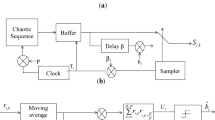Abstract
In this paper, digital chaotic communications in multiple-input–multiple-output (MIMO) wireless multipath fading channels is considered. A noise reduction-differential chaos shift keying (NR-DCSK) scheme is employed to modulate data symbols at each transmit antenna which transmits signals omni-directionally. In the transmitter side, we use β/P chaotic samples as reference sequences which is then repeated P times to generate the required reference sequence of length β. At the receiver side, a moving average filter of size P is used to reduce the noise variance of the received signal so as to enhance the system performance. The resulting filtered signal is then correlated and combined using diversity combining techniques to yield the transmitted symbol. It is shown that with spatial diversity gains, the enhancement in bit error rates (BER) of the proposed system is much better than the conventional M-DCSK based MIMO Chaotic Communication systems. Moreover, a closed-form expression for BER of the proposed system is derived over AWGN and Rayleigh fading channel conditions. Comparison of simulation results with theoretical BER expressions of additive white Gaussian noise (AWGN) and Rayleigh fading channels for various system parameters like signal to noise ratio, Spatial diversity orders, combining techniques have been carried out to test the performance enhancement of the proposed NR-DCSK based MIMO system.







Similar content being viewed by others
References
Lau, F. C. M., & Tse, C. K. (2003). Chaos-based digital communication systems. Berlin: Springer.
Kolumbán, G., Kennedy, M. P., Jákó, Z., & Kis, G. (2002). Chaotic communications with correlator receivers: Theory and performance limits. Proceedings of the IEEE, 90(5), 711–731.
Abel, A., & Schwarz, W. (2002). Chaos communications-principles, schemes, and system analysis. Proceedings of the IEEE, 90(5), 691–710.
Kolumbán, G., Kennedy, M. P., & Kis, G. (1998). FM-DCSK: A novel method for chaotic communications. In Proceedings of international symosium on circuits systems, CA, USA (pp. 477–480).
Wang, L., Zhang, C. X., & Chen, G. R. (2008). Performance of an SIMO FM-DCSK communication system. IEEE Transactions on Circuits Systems II: Express Briefs, 55(5), 457–461.
Duman, T. M., & Ghrayeb, A. (2007). Coding for MIMO communication systems. West Sussex: Wiley.
Thapaliya, K., Yang, Q. H., & Kwak, K. S. (2007). Chaotic communications in MIMO systems. In Proceedings of 3rd international conference on embedded software systems, Daegu, Korea (pp. 708–717).
Zheng, G., Boutatb, D., Floquetc, T., & Barbot, J. P. (2009). Secure communication based on multi-input multi-output chaotic system with large message amplitude. Chaos, Solitons & Fractals, 41(3), 1510–1517.
Wang, S., & Wang, X. (2010). M-DCSK based chaotic communications in MIMO multipath channels with no channel state information. IEEE Transactions on Circuits and Systems-II: Express Briefs, 57(12), 1001–1005.
Kaddoum, G., Vu, M., & Gagnon, F. (2011). Performance analysis of differential chaotic shift keying communications in MIMO systems. In Proceedings of 2011 IEEE symposium on circuits and systems, Rio de Janeiro, Brazil.
Sangeetha, M., & Bhaskar, V. (2012). EGC diversity incorporated BER performance analysis of M-DCSK schemes in MIMO Nakagami channels. In Proceedings of international conference on computational intelligence-part 1, Bangalore (Vol. 292, pp. 74–83).
Fang, Y., Xu, J., Wang, L., & Chen, G. (2012). Performance of MIMO relay DCSK-CD systems over Nakagami fading channels. IEEE Transactions on Circuits and Systems I: Regular Papers, 60(3), 757–767.
Wang, S., Lu, S., & Zhang, E. (2013). MIMO-DCSK communication scheme and its performance analysis over multipath fading channels. Journal of System Engineering and Electronics, 24(5), 729–733.
Yoon, S. W., Lee, J. H., & Ryu, H. R. (2014). Chaos communication systems using MIMO technique. In Proceedings of 16th international conference on advanced communication technology (ICACT), Korea.
Salahat, E., Shehada, D., & Yeun, C. Y. (2015). Novel performance analysis of multi-access MIMO relay cooperative RM-DCSK over Nakagami-m fading subject to additive white generalized Gaussian noise (AWGGN). In Proceedings of IEEE 82nd vehicular technology conference, Boston, USA (pp. 1–5).
Kpre, E. L., Fromenteze, T., & Decroze, C. (2016). MIMO radar transmit array fed by a 1 × M passive chaotic cavity. In Proceedings of 10th European conference on antennas and propagation (EuCAP), DAVOS, Switzerland (pp. 1–5).
Mrinalee, S., & Mukul, M. K. (2016). Performance analysis of the MIMO system using the chaos shift keying. In Proceedings of the IEEE international conference on recent trends in electronics, information and communication technology (RTEICT), Bengaluru (pp. 1824–1828).
Salahat, E. (2016). On the performance of DCSK MIMO relay cooperative diversity in Nakagami-m and generalized Gaussian noise scenarios. In Proceedings of the 42nd annual conference of the IEEE industrial electronics society, Italy (pp. 7203–7207).
Jemaa, Z. B., & Belghith, S. (2016). Chaotic sequences with good correlation properties for MIMO radar application. In Proceedings of 24th international conference on software, telecommunications and computer networks (SoftCOM), Split, Croatia (pp. 1–5).
Quyen, N. X., Lam, N. T., et.al. (2017). Chaos-based spread-spectrum using M-ary PSK and OFDM-MIMO. In Proceedings of international conference on recent advances in signal processing, Da Nang, Vietnam (pp. 205–210).
Kaddoum, G., & Soujeri, E. (2016). NR-DCSK: A Noise Reduction Differential Chaos Shift Keying Systems. IEEE Transactions on Circuits and Systems II: Express Briefs, 63(7), 648–652.
Shynk, J. J. (2012). Probability, random variables, and random processes: Theory and signal processing applications. London: Wiley.
Rappaport, T. S. (2013). Wireless communications: Principles and practice (2nd ed.). New York: Pearson.
Ng, E. W., & Geller, M. (1969). A table of integrals for the error functions. Journal of Research of the National Bureau of Standards-B. Mathematical Sciences, 73B, 1–20.
Author information
Authors and Affiliations
Corresponding author
Additional information
Publisher's Note
Springer Nature remains neutral with regard to jurisdictional claims in published maps and institutional affiliations.
Rights and permissions
About this article
Cite this article
Sangeetha, M., Bhaskar, V. NR-DCSK Based Chaotic Communications in MIMO Multipath Channels. Wireless Pers Commun 103, 1819–1834 (2018). https://doi.org/10.1007/s11277-018-5882-3
Published:
Issue Date:
DOI: https://doi.org/10.1007/s11277-018-5882-3




